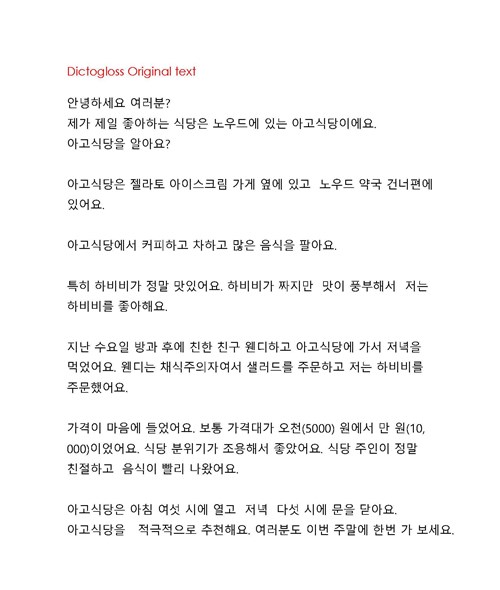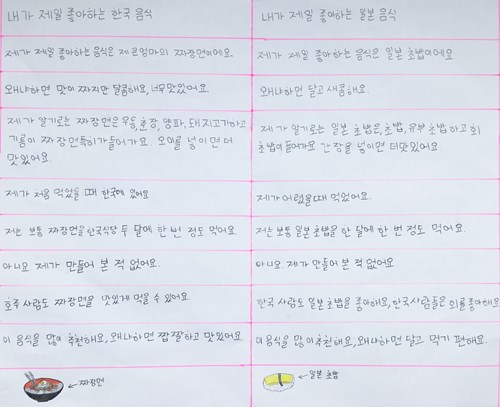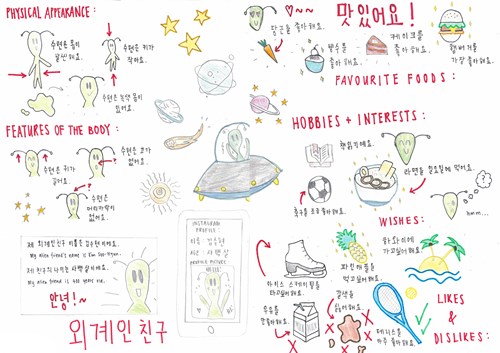Languages: Korean - Satisfactory - Years 7 and 8 (Year 7 entry)
Portfolio summary
This portfolio of student work shows that the student uses Korean to interact with others (WS3) and teachers (WS8) in classroom routines and activities, exchanging greetings, wishes, experiences, interests and information (WS1, WS8). The student approximates different sounds and intonation patterns of Korean during spoken interaction, and constructs and combines Hangeul syllable blocks appropriately to write words and sentences (WS1, WS3, WS8, WS9). The student greets others using formulaic language (WS4) and exchanges basic personal information (WS1, WS3, WS8). The student asks and responds to simple questions using an –이에요/예요 or –어/아요 verb ending appropriately (WS1, WS3, WS4, WS8). The student maintains interaction by using formulaic expressions or set phrases (WS3, WS8) to give simple feedback and to offer their own opinions (WS1, WS6, WS8). The student gives and follows simple instructions such as 일어나세요, 앉으세요, ..., makes simple arrangements and engages in transactions such as making and responding to polite requests. The student negotiates wishes and expresses possibility or capability using set phrases (such as ...–고 싶어요, ...–(으)ㄹ 수 있어요) (WS6). The student uses familiar vocabulary to describe familiar objects, people, pets, routines and contexts (WS2, WS3, WS4, WS6, WS7, WS8, WS9) and appropriate grammatical elements such as basic case markers and particles in simple sentences (WS1, WS2, WS3, WS4, WS6, WS7, WS8). The student describes present and past events (WS2, WS6) and expresses aspects of action or appearance in set phrases (WS1, WS6, WS7). The student asks questions using a range of question words, and makes negations (WS6, WS7) by using 안/못 for common verbs (WS1) and by replacing copula ...이에요/예요 with a set phrase ...이/가 아니예요 (WS7). The student describes quality or state (WS1, WS8) and action (WS4, WS7), and uses a suffix –었/았–for past events (WS2, WS6). The student refers to themselves using different forms of first person pronouns appropriately (WS2, WS3, WS6, WS7, WS8, WS9) and refers to objects using pronouns 이것, 저것 or 그것 according to the context (WS4, WS6). The student uses some honorific words and suffixes as part of formulaic expressions (WS2, WS4, WS6). The student expresses numbers using pure Korean and Sino-Korean number systems, basic counters and Arabic numerals with appropriate pronunciation, in appropriate word order (WS2, WS3, WS4, WS6, WS7, WS8, WS9). The student creates texts using modelled sentence structures, formulaic expressions and set phrases (WS3, WS4, WS6, WS7, WS9). The student builds text cohesion by using basic qualifying adverbs (WS4, WS6), time adverbs (WS2) and basic conjunctives (WS6, WS7, WS8) and by maintaining consistency in the use of polite verb endings and honorific elements (WS2, WS3, WS4, WS6, WS7, WS8, WS9). The student translates texts, predicting meanings by relying on knowledge of their first language, of textual features and of key words, including loan words from English WS2). The student creates simple bilingual texts in different modes and formats, identifying culture-embedded language such as 우리 used in the context where it means ‘my’ in English (WS7, WS9). The student compares their experiences of learning and using Korean, identifying how the experience of learning Korean has broadened their intercultural perspectives and understanding of other cultures (WS2, WS5).
The student describes how Korean is used not only in Korea and in the Korean community in Australia but also in the global context (WS5). The student explains how languages and cultures change through contact by giving examples of Korean words known and used in other languages, loan words in contemporary Korean borrowed from English (WS9), and words with similar meanings or pronunciation across languages such as Korean, Chinese, Japanese and some European languages (WS5). The student demonstrates their understanding of the alphabetic nature of Hangeul by identifying consonant and vowel letters and explaining how to combine them to construct a syllable block (WS2) and explains how Hangeul was created to correspond to the Korean sound system. The student explains basic features of Korean and English using metalanguage (WS5) and applying their understanding of rules for writing Hangeul, for pronunciation, for grammar and for text organisation in Korean. The student identifies how politeness is expressed explicitly and systematically through grammar and vocabulary in Korean and describes how the level of politeness in speech style is determined by the age and social relationships of participants in interactions in Korean (WS4, WS5). The student describes how the spoken and written forms of a language change over time for example, by differentiating between older and modern versions of Hangeul script (WS5). The student demonstrates their understanding of the close relationship between language and culture by describing how Korean language reflects ways of thinking and behaving associated with Korean people and their lifestyles (WS5). The student adjusts their language use to suit situations and contexts and uses non-verbal elements in culturally appropriate ways when using Korean.








